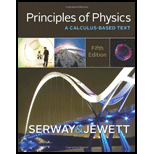
Concept explainers
(a)
The change in kinetic energy of the disk.
(a)
Answer to Problem 73P
The change in kinetic energy of the disk is
Explanation of Solution
Given info: The radius of copper disk is
Write the equation for change in kinetic energy of the disk.
Here,
Write the equation of conservation of
Substitute
Write the formula for initial moment of inertia
Here,
m is the mass of the disk.
r is the radius of disk.
t is the thickness of copper disk.
The density of copper is
Substitute
Write the equation of conservation of angular momentum to calculate the final angular speed of the disk.
Further solve the above equation to calculate the final angular speed of the disk.
Here,
The value of coefficient of linear expansion
Substitute
Substitute
Conclusion:
Therefore, the change in kinetic energy of the disk is
(b)
The change in internal energy of the disk.
(b)
Answer to Problem 73P
The change in internal energy of the disk is
Explanation of Solution
Given info: The radius of copper disk is
Write the equation to calculate the change in internal energy of the disk.
Here,
Q is the energy required to change the temperature of substance.
c is the specific heat of the copper disk.
Specific heat of copper disk is
Substitute
Conclusion:
Therefore, the change in internal energy of the disk is
(c)
The amount of radiated energy.
(c)
Answer to Problem 73P
The amount of radiated energy is
Explanation of Solution
Given info: The radius of copper disk is
Write the equation for change in kinetic energy of the disk to calculate the amount of radiated energy.
Here,
Substitute
Conclusion:
Therefore, the amount of radiated energy is
Want to see more full solutions like this?
Chapter 17 Solutions
Bundle: Principles of Physics: A Calculus-Based Text, 5th + WebAssign Printed Access Card for Serway/Jewett's Principles of Physics: A Calculus-Based Text, 5th Edition, Multi-Term
- 20. Two small conducting spheres are placed on top of insulating pads. The 3.7 × 10-10 C sphere is fixed whie the 3.0 × 107 C sphere, initially at rest, is free to move. The mass of each sphere is 0.09 kg. If the spheres are initially 0.10 m apart, how fast will the sphere be moving when they are 1.5 m apart?arrow_forwardpls help on allarrow_forwardpls help on thesearrow_forward
- pls help on all asked questions kindlyarrow_forwardpls help on all asked questions kindlyarrow_forward19. Mount Everest, Earth's highest mountain above sea level, has a peak of 8849 m above sea level. Assume that sea level defines the height of Earth's surface. (re = 6.38 × 106 m, ME = 5.98 × 1024 kg, G = 6.67 × 10 -11 Nm²/kg²) a. Calculate the strength of Earth's gravitational field at a point at the peak of Mount Everest. b. What is the ratio of the strength of Earth's gravitational field at a point 644416m below the surface of the Earth to a point at the top of Mount Everest? C. A tourist watching the sunrise on top of Mount Everest observes a satellite orbiting Earth at an altitude 3580 km above his position. Determine the speed of the satellite.arrow_forward
- pls help on allarrow_forwardpls help on allarrow_forward6. As the distance between two charges decreases, the magnitude of the electric potential energy of the two-charge system: a) Always increases b) Always decreases c) Increases if the charges have the same sign, decreases if they have the opposite signs d) Increases if the charges have the opposite sign, decreases if they have the same sign 7. To analyze the motion of an elastic collision between two charged particles we use conservation of & a) Energy, Velocity b) Momentum, Force c) Mass, Momentum d) Energy, Momentum e) Kinetic Energy, Potential Energyarrow_forward
 Principles of Physics: A Calculus-Based TextPhysicsISBN:9781133104261Author:Raymond A. Serway, John W. JewettPublisher:Cengage Learning
Principles of Physics: A Calculus-Based TextPhysicsISBN:9781133104261Author:Raymond A. Serway, John W. JewettPublisher:Cengage Learning Physics for Scientists and Engineers: Foundations...PhysicsISBN:9781133939146Author:Katz, Debora M.Publisher:Cengage Learning
Physics for Scientists and Engineers: Foundations...PhysicsISBN:9781133939146Author:Katz, Debora M.Publisher:Cengage Learning Physics for Scientists and Engineers, Technology ...PhysicsISBN:9781305116399Author:Raymond A. Serway, John W. JewettPublisher:Cengage Learning
Physics for Scientists and Engineers, Technology ...PhysicsISBN:9781305116399Author:Raymond A. Serway, John W. JewettPublisher:Cengage Learning
 Physics for Scientists and EngineersPhysicsISBN:9781337553278Author:Raymond A. Serway, John W. JewettPublisher:Cengage Learning
Physics for Scientists and EngineersPhysicsISBN:9781337553278Author:Raymond A. Serway, John W. JewettPublisher:Cengage Learning Physics for Scientists and Engineers with Modern ...PhysicsISBN:9781337553292Author:Raymond A. Serway, John W. JewettPublisher:Cengage Learning
Physics for Scientists and Engineers with Modern ...PhysicsISBN:9781337553292Author:Raymond A. Serway, John W. JewettPublisher:Cengage Learning





